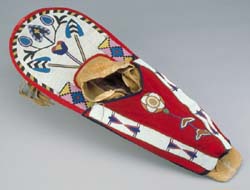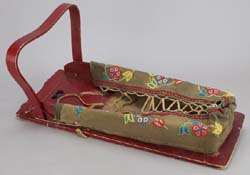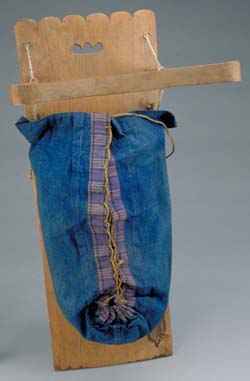
![]()
Cradle Boards
 |
Cradle-Board ; Kootenay; British Columbia, Canada; Length: 100.0 cm. Width: 37.0 cm. Most of the Aboriginal peoples of North America used cradle boards to carry their babies until they were weaned and able to walk. The use of the cradle board ensured that the baby was always with his or her mother and could be fed whenever hungry. |
 |
Cradle Board; Eastern Subarctic, Eastern Woods Cree; Constance Lake, Ontario, Canada; Length 80.0 cm, Width 31.0 cm, Thickness 1.7 cm. First Peoples babies wore no clothing. They were wrapped in soft coverings, such as the inner barks of trees, fur, or smooth animal skin, and then strapped or laced onto the boards. Moss, or a similar absorbent materiel, was placed beneath the babies as a sort of diaper. |
 |
Cradle Board; Date collected 1915; James Bay Cree; Waswanipi, Quebec, Canada; Length 39.7 cm, Width 11.9 cm, Depth 11.5 cm. The cradles were either flat or slightly hollowed-out troughs made from various materials. The Salish of British Colombia used finely woven cedar baskets cradles; some Subarctic tribes used sewn bark; and others, for example the people of the Eastern Woodlands, used single flat boards. The Plains people used stiffened rawhide. The Inuit counterpart to the cradle board was the extra large hood on the mother's parka. The baby was carried in the hood, which was closed off at the bottom by a strap fastened around the mother's waist. |
